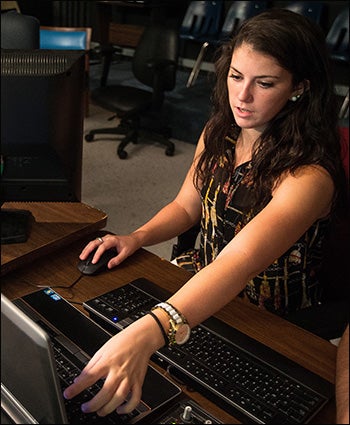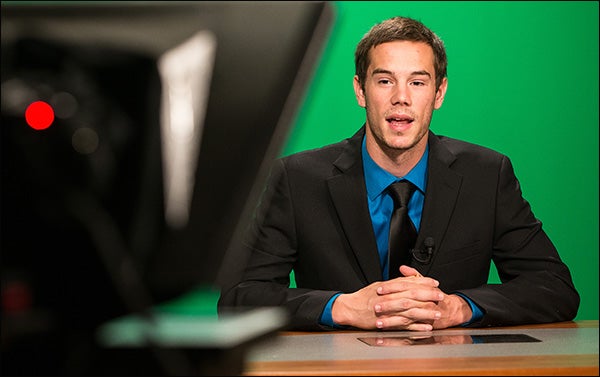THE RIGHT EQUIPMENT
Multimedia newsroom enhances learning for ECU broadcast students
Senior Alex Gajewski knows what he wants to do after graduation. The aspiring sports broadcaster has held internships with ESPN radio, TV stations in Greenville and Charlotte, NASCAR Productions and a professional soccer team.
Equally valuable, however, is the experience he gets weekly on campus at East Carolina University.
“The ECU multimedia newsroom is phenomenal,” Gajewski said in an interview this fall. “I can’t say enough about it. I started getting hands on with the ECU newsroom my junior year and it has helped me tremendously. It really captures what it’s like to work in TV journalism.”
The multimedia newsroom in Joyner East was first put into use this spring by School of Communication students. With each semester, a new group gets the chance to learn valuable job skills before graduation.

ECU student Kala Godwin works behind the scenes producing a news broadcast in the multimedia newsroom.
The facility includes new computers, three studio cameras, a TriCaster, an audio board, an anchor desk and a green screen. The newsroom’s virtual sets enable the plain green backdrop of the anchoring desk to be transformed into a city skyline and a dozen other scenes.
How close does it come to a real newsroom experience?
“It’s pretty close,” said Dr. Mary Tucker-McLaughlin, a communication professor who regularly teaches in the newsroom. “They’re using all the technology, they’re writing their own shows and producing their own shows.”
Tucker-McLaughlin said it’s a serious upgrade from the days of filming with good cameras but no real set in Joyner Library.
Students taking “Editing and Producing the News” create five- to six-minute news updates weekly about events happening on and around ECU’s campus, she said. They spend one day each week writing and planning the show and one day creating the broadcast.
Ryan Clark, an ECU senior interested in working in or teaching in broadcast production, said the TriCaster has been the most valuable addition to his learning experience. That particular piece of equipment is used to control the cameras in use, the green screen, video footage and graphic cues all at once.
“I’m not great at it by any means but just the fact that equipment is available to work with daily is truly a wonderful thing,” Clark said. “The mock shows we produce also get us used to the things that look good when they happen but also the things that can go wrong.”
Tucker-McLaughlin agreed those can be valuable lessons.
“Until they (produce a show), they don’t realize how hard it is and how many things – little things – can go wrong,” she said.
Communication professor Dr. Glenn Hubbard also teaches in the newsroom – primarily ‘Video News Production’ and ‘Electronic News Performance’ – and said the benefits are clear.
“The room is amazing because it allows us to incorporate virtually all elements of electronic news into any class – video production, editing, writing, newsgathering, studio TV production, anchoring, “ Hubbard said. “We sometimes do everything I just listed in one class period, whereas teaching this stuff used to require scheduling multiple facilities and setting up different equipment for different lessons.
“Simply put, it has made our teaching much easier and more effective.”

ECU senior Alex Gajewski practices his broadcasting skills in the School of Communications’ multimedia classroom.